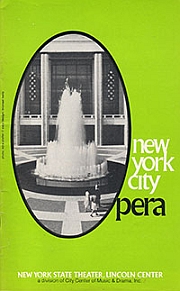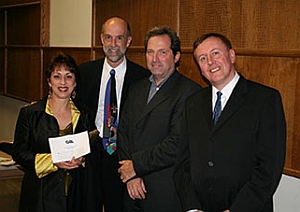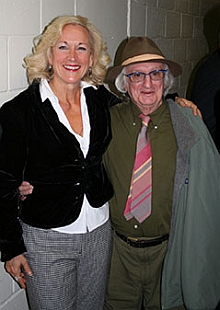
program cover for the
original 1975 production of
“Die tote Stadt.”
New York City 2001
“A Major Revival:
Erich Wolfgang Korngold’s
Die tote Stadt”
by Troy O. Dixon October 2006
There’s not a cloud in the sky on this cool Saturday in New York City as people migrate their way to Lincoln Center for this year’s final performance of a landmark production. It’s atypically warm for the 14th of October as we make our way across the street shortly before a noontime pre-performance lecture is scheduled to begin. Among the many dignitaries and luminaries that will eventually grace the New York State Theater this afternoon, Kathrin Korngold, granddaughter of the composer Erich Wolfgang Korngold, and Brendan G. Carroll, biographer and world-authority on Erich Korngold and his music, enjoy a happy reunion before descending to the backstage area where the lecture is to be held.

with Korngold’s granddaughter and her husband, and Brendan Carroll. In a practice room somewhere behind and below the theater stage, a large group of attendees listens intently as Michael P. Steinberg (Prof. of History, Director of the Cogut Center for the Humanities, and Prof. of Music at Brown University) presents a wonderfully illuminating presentation on Korngold’s most famous opera Die tote Stadt. Complimented with video examples, Prof. Steinberg’s lecture not only provides a basic history and framework for Georges Rodenbach’s novelette Bruges-la-Morte, upon which Korngold’s opera is based, but makes fascinating comparisons between Rodenbach’s novelette, Korngold’s opera, and the Hitchcock film thriller Vertigo. The audience is treated to a brief history of the Rodenbach story’s many incarnations – including the play Die stille Stadt (1902), the Russian film Gryozy (“Daydreams” – 1915), and Fritz Lang’;s The Woman in the Window (1944) -; and a brief diversion into aspects of Freudian interpretation of dreams.
At its completion, the lecture attendees make their way back up to the theater lobby to join a host of others here to enjoy this season’s revival of the New York City Opera’s 1975 production of Korngold’s Die tote Stadt. At the time, the 1975 staging was the first American production of this important opera in over 50 years. That it has continued to be revived every few years ever since, makes this production the longest running of any staging of Die tote Stadt – and perhaps the most pioneering. This landmark production involves a unique use of film and photographic projections on a scrim permanently placed in front of the main action of the opera. While obscuring slightly the audience’s ability to see details of the action and sometimes to hear some of the quieter passages in the vocal parts, the transparent screen provides a subtle homage to Korngold’s career in Hollywood during the 1930s and 40s.
Despite the most-often heard criticism that the distinction between reality and the dream world – vitally inherent to the story line of this opera’s drama – was rather unclear to both first-time attendees and some veterans of other productions, the performance is a wonder to experience. The subtly shifting projections of patterns, colors, and occasional film montages, all serve to well convey a sense of the libretto’s requirements, as well as enhancing the moods of the scenes. And beneath, above, and around it all is the lush, late-Romantic music of Erich Wolfgang Korngold.
One of the last of the Romantic composers, Erich Wolfgang Korngold represents a musical style that has sometimes been described as a descendant and synthesis of Richard Strauss, Mahler, Wagner, and Schreker. Regardless, the music sweeps those in attendance away, transporting them into a sound world unlike any other, and depositing them fully into Paul’s Dead City. Korngold’s music has often been described as “demanding of listener’s attention,” and this afternoon’s performance lends credence to this notion.
During the first intermission, Brendan Carroll and Katy Korngold are graced by the appearance of Renee Fleming, unexpectedly seated just across the aisle for this performance. Her newest album “Homage: The Age of Diva” is due for release in only three days, and here she sits in the audience of an opera originally premiered over 85 years ago by one of those famous diva her album pays homage to, Maria Jeritza, the original Marie/Marietta in the premiere of Die tote Stadt in Hamburg. During their conversation, Ms. Fleming comments that Maestro Gergiev (conductor on her latest CD) and the orchestra were most impressed with the Korngold arias and loved performing them. She also explains that she will tour the repertoire of the CD this coming autumn in Europe. (The album has already received a glowing review in GRAMOPHONE with the Korngold arias especially getting a commendatory mention.)
We return to our seats for the second act, the main thrust of the story line’s dream sequence. It is in this act that the famous “Pierrot’s Tanzlied” aria occurs, and in this role, Keith Phares delivers an outstanding performance. His success is later confirmed by the audience who awards him the most enthusiastic display of applause during curtain call at the close of the performance. The dance sequences and parades envisaged by Paul in his dreaming state are wonderfully performed, and in some respects are more satisfying than the same sequences in Donald Runicles’ production at Salzburg 2004, a production which is now reputed to be part of the Vienna opera repertory.
The second intermission provides an opportunity for meeting in the Green Room with representatives of the opera, publishing houses, recording studios and others. But after only a few brief moments of refreshments and conversation, and the bell sounds for the completion of the most famous opera by this still somewhat unknown Austrian composer.

The third act brings the dream sequence to its conclusion. Paul receives his revelations, the past is put behind him, and he decides to move forward into tomorrow, out of the perpetual yesterdays of his recent existence. The music fades in the hall itself, but lingers in the mind’s ear.

Ms. Ellison brings the entourage downstairs (I think it’s downstairs – the backstage area is a more of a maze to the unfamiliar than anything else) where Katy meets the conductor of this performance, Maestro George Manahan. And during the meeting, seemingly by chance, Maestro Julius Rudel walks past. Conductor of the NYCO company for 22 years (1957-1979), Maestro Rudel was NYCO’s Music Director for the first production of “Die tote Stadt” in 1975. The convergence of the current conductor, the original music director, and Korngold’s granddaughter is a magical moment.
The backstage is beginning to quiet. The performance is over. The players are leaving and the staff is beginning to shut down. But the memory of the opera still lingers. Just as it has lingered for thirty years. And perhaps for thirty more to come.
Read the special introduction for the 2006 Opera programme
written by Mr. Brendan Carroll for Playbill
Read the New York Times 1975 article
Read the New York Times 2006 article
Originally posted October 2006 — reformatted September 2011
